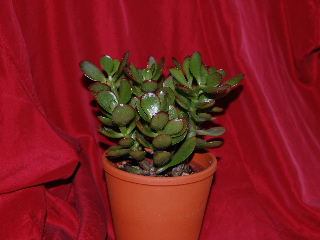
Commonly grown as a houseplant, the jade plant (Crassula ovata) is a succulent that originated in South Africa.
Also read:
Succulents--Ideal Plants For An Unusual Dish Garden
Being a succulent, the jade is undemanding of water, requiring only minimal to normal waterings during the warm growing season of summer and little to no water during the dormant season of winter.
The evergreen nature of the jade plant and its delicate but hardy appearance--soft oval-shaped greenish leaves and a grayish woody stem--make it a popular choice for an unusual houseplant.
Also, the unusual appearance and the undemanding nature of the jade plant make it an excellent choice for a plant to be shaped and grown into a bonsai houseplant.
Not only does the jade not NEED much water because of its classification as a succulent (plants that store moisture in their leaves, stems, and roots), the jade actually doesn’t WANT much water, as an excess will lead to dropping of leaves, rotting of stems and roots, and eventually to the death of the plant.
For this reason, a loose planting medium with a mixture of organic potting soil, sand, and perlite is required in order for the added water to drain away from the plant so as not to leave it standing in water or in soggy soil.
In terms of light requirements, the jade houseplant needs several (up to 4) hours of sunlight each day, so placement in or near a southern exposure window is a good idea. Also, filtered sunlight or some sun and shade mixed is desirable for a potted jade plant that has been moved outdoors for the summer months.
Too much heat from the direct hot rays of the sun will burn the leaves of the jade plant.
And in terms of low temperatures, jade does not tolerate the cold well and prefers temperatures that do not fall below 40 degrees.
Propagation is easily accomplished by means of stem cuttings or leaf cuttings. A rooting medium of moist sand works well and will quickly lead to the formation of sufficient roots on the cuttings to start any number of new jade plants.
The jade is relatively pest free. Mealybugs can be eliminated by dabbing them with a little bit of rubbing alcohol applied to a Q-tip.
Jade plants can sometimes be induced into blooming as they move into the dormant season, with the lessening or stopping of water and with the increased darkness of the shorter daylight hours of approaching winter.
It responds to the same treatment as poinsettia does to produce blooms. Also read:
Poinsettias--Keep Christmas Blooms Coming Back Year After Year
The blooms of the jade plant are small, star-shaped, and white.
 Commonly grown as a houseplant, the jade plant (Crassula ovata) is a succulent that originated in South Africa.
Commonly grown as a houseplant, the jade plant (Crassula ovata) is a succulent that originated in South Africa.